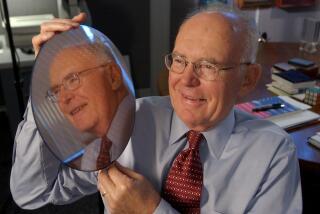Reynold Johnson; ‘Father’ of Disk Drive
- Share via
Reynold B. Johnson, known as the father of the computer disk drive and a prolific inventor whose patents ranged from a type of videotape to talking books, died in San Jose on Tuesday of cancer. He was 92.
Johnson led the IBM laboratory in San Jose that in 1956 developed a way to store computer data on a metal disk instead of tape or a drum. The random access method of accounting control led to the establishment of an IBM division as a major force in Silicon Valley and launched a multibillion-dollar computer disk drive industry.
Johnson also invented many other devices. Every teacher who has given a multiple-choice test can appreciate one of his first creations.
As a Michigan high school teacher during the Depression, he developed a way to electronically record test scores using pencils. Beatrice Rashleigh, a teaching colleague and later his wife of 64 years, wrote a newspaper story about the device. An IBM salesman saw it and gave Johnson a job.
Johnson was also responsible for the half-inch videocassette tapes used by Sony today. While on loan to Sony for another project, he came up with a prototype of a VCR tape less than half the width of the tape Sony was then putting on reels.
During his 35 years with IBM, Johnson launched the company’s West Coast operations, put his name on at least 90 patents and watched the industry improve on his ideas again and again.
In the 1950s, he had to overcome doubts in coming up with a model for the disk file. It stacked up to 50 24-inch-diameter platters with 5 megabytes of storage space and weighed 1 ton.
More than 40 years later, IBM’s new micro-drive has a 1-inch-diameter platter with 340 megabytes of storage space. It is 1.7 inches long, 1.4 inches wide and 0.2 inch thick, and weighs less than a double-A battery.
“Rey was always looking for new ideas, new concepts and, because he was a creative person himself, to throw in a few ideas of his own,” said Jack D. Kuehler, who was hired by Johnson and eventually rose to become IBM’s president before retiring in 1993.
“He was constantly walking through the lab. You felt he was your father, tutoring and helping. . . . You always felt he could do your job better than you could, and he challenged you to climb the ladder of concept and creativity.”
Johnson kept inventing after he retired from IBM in 1971, including creating a micro-phonograph that is the technology behind the “Talk to Me Books” for children.
His awards include the National Medal of Science, presented by President Ronald Reagan in 1986.
Johnson is survived by his wife, two sons, a sister, two brothers and five grandchildren.
More to Read
Inside the business of entertainment
The Wide Shot brings you news, analysis and insights on everything from streaming wars to production — and what it all means for the future.
You may occasionally receive promotional content from the Los Angeles Times.










